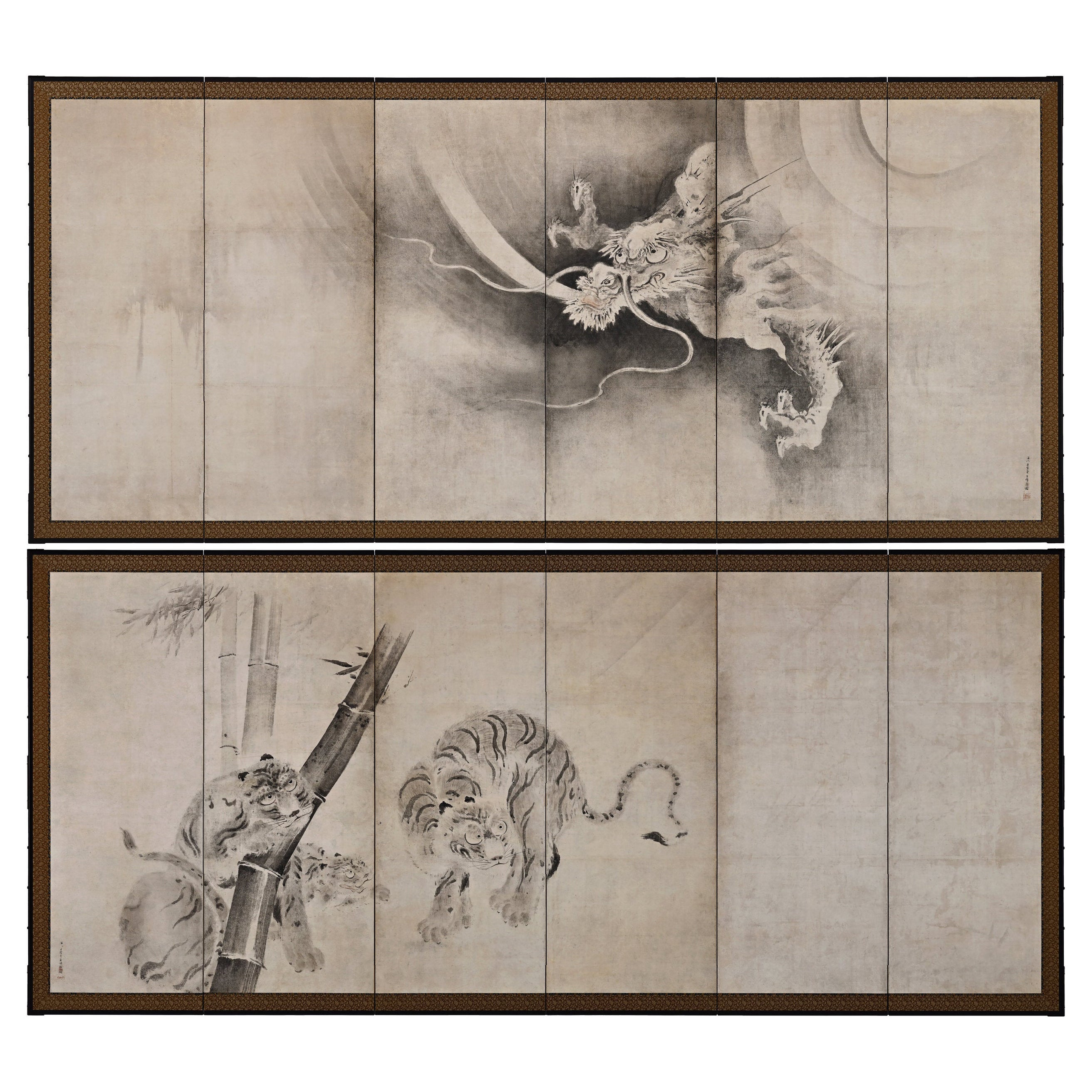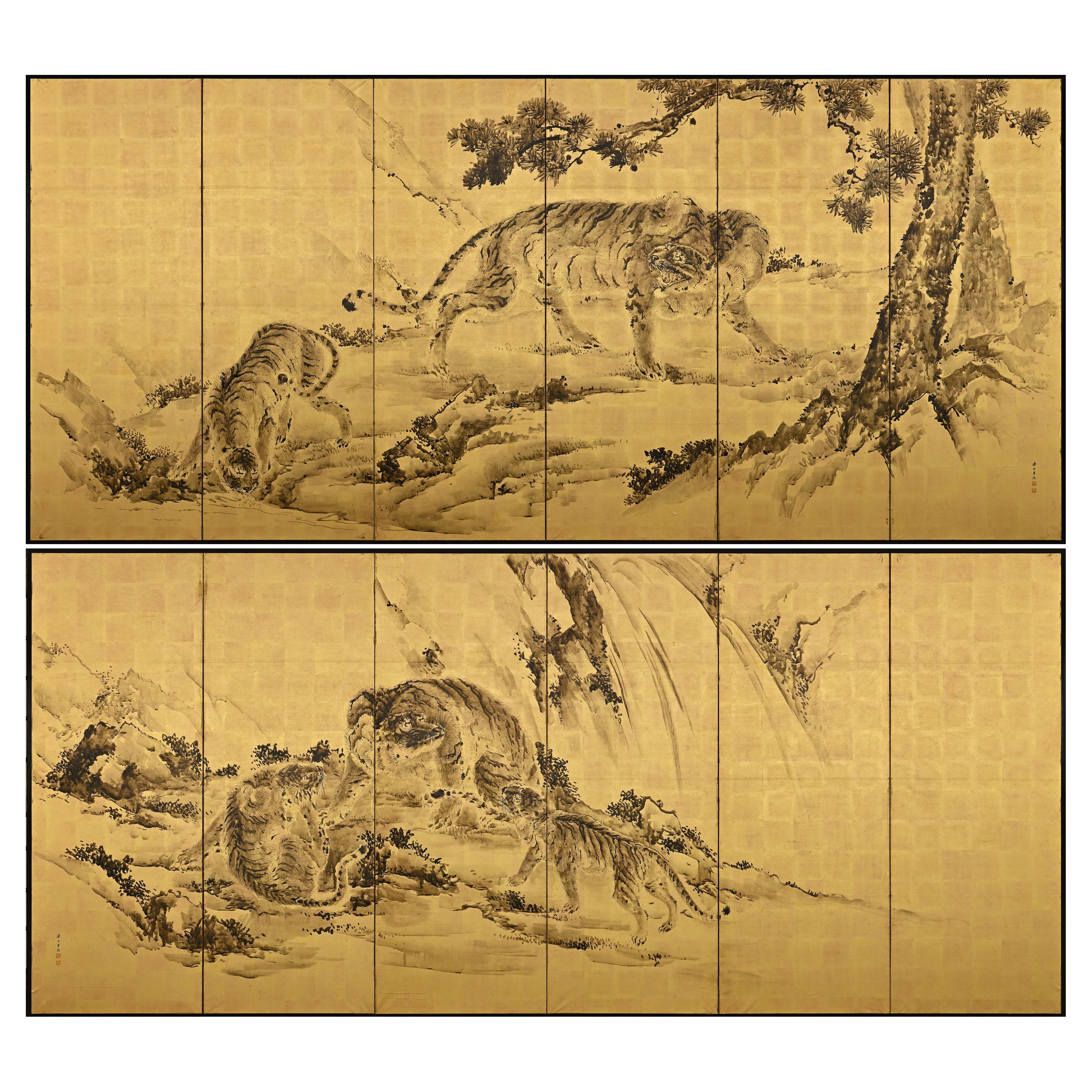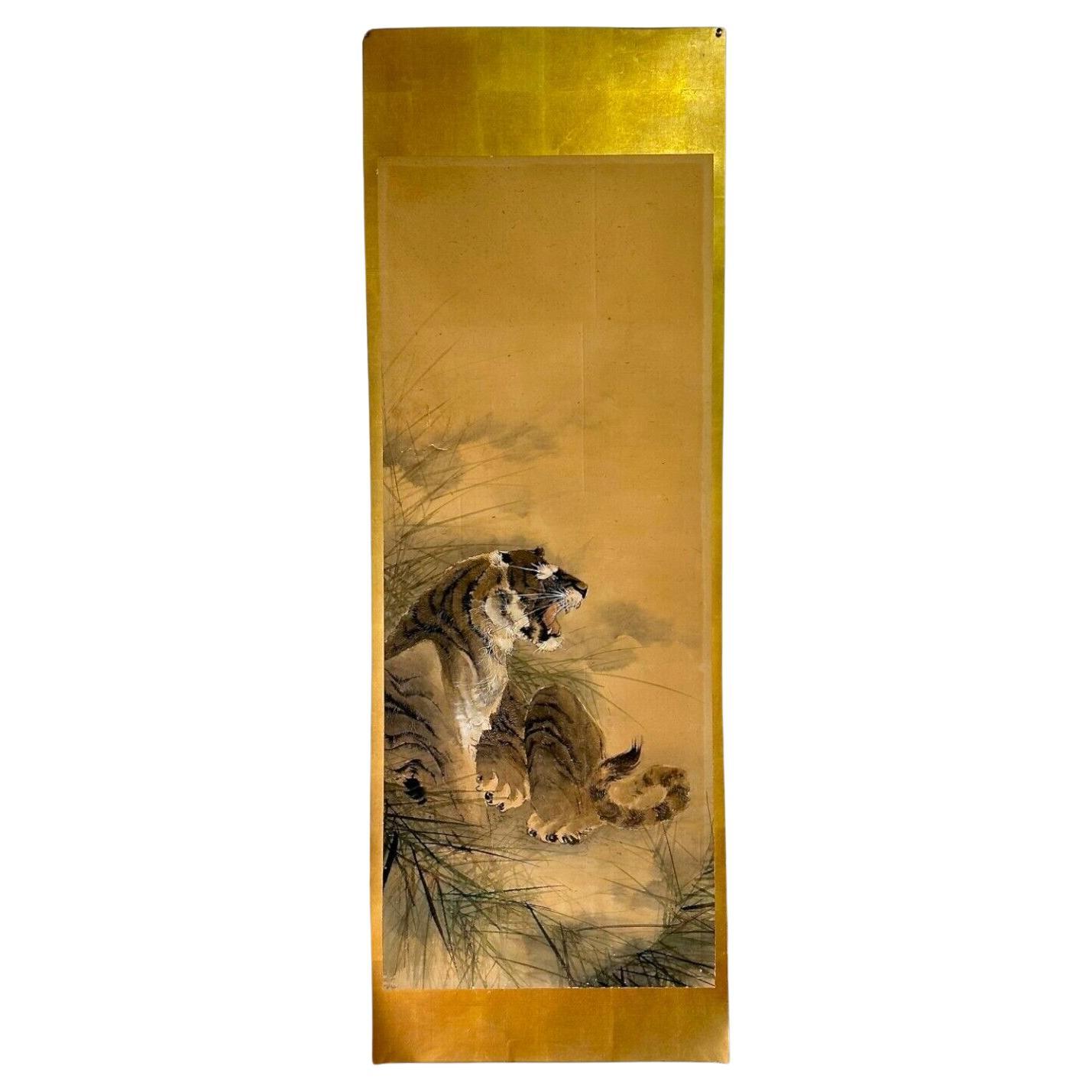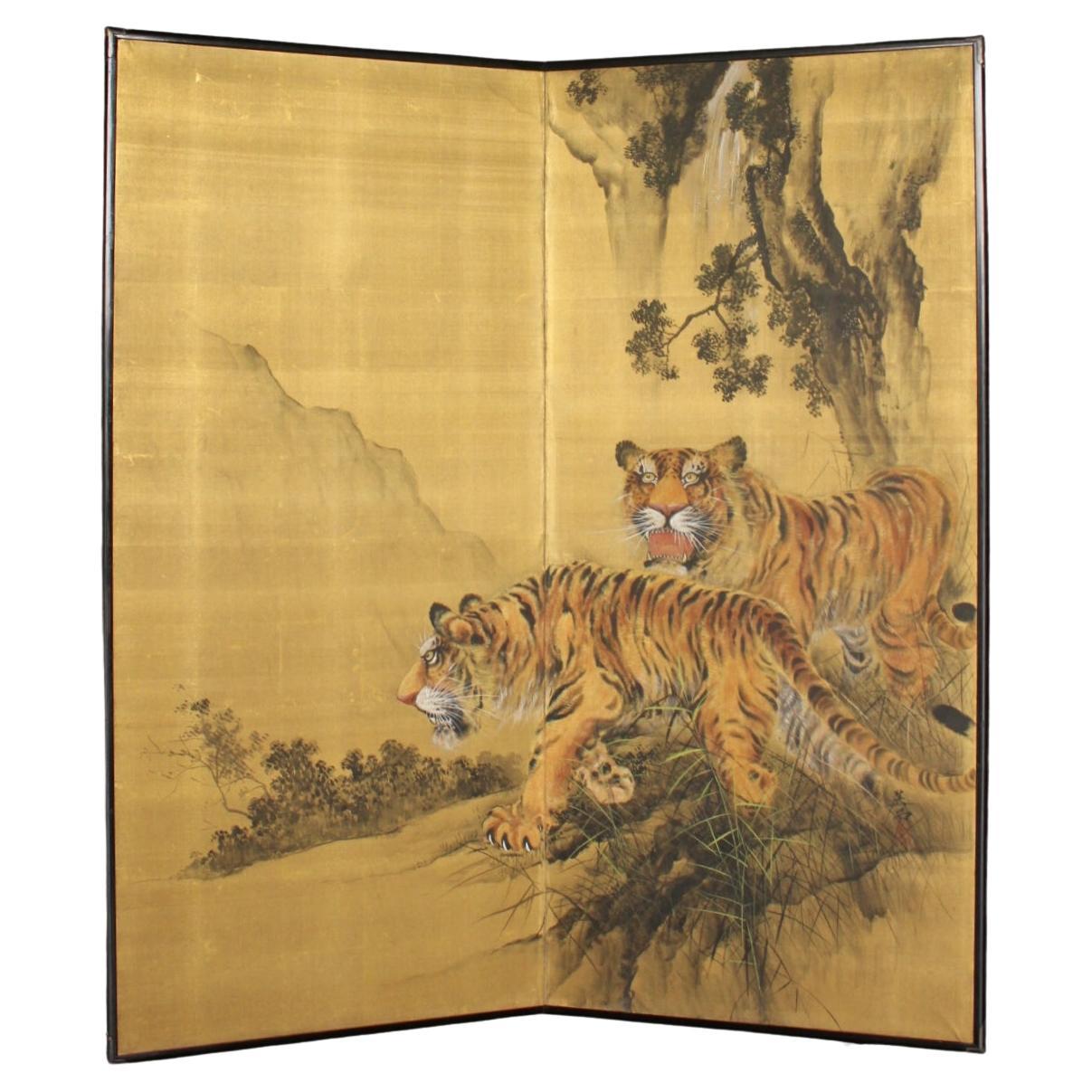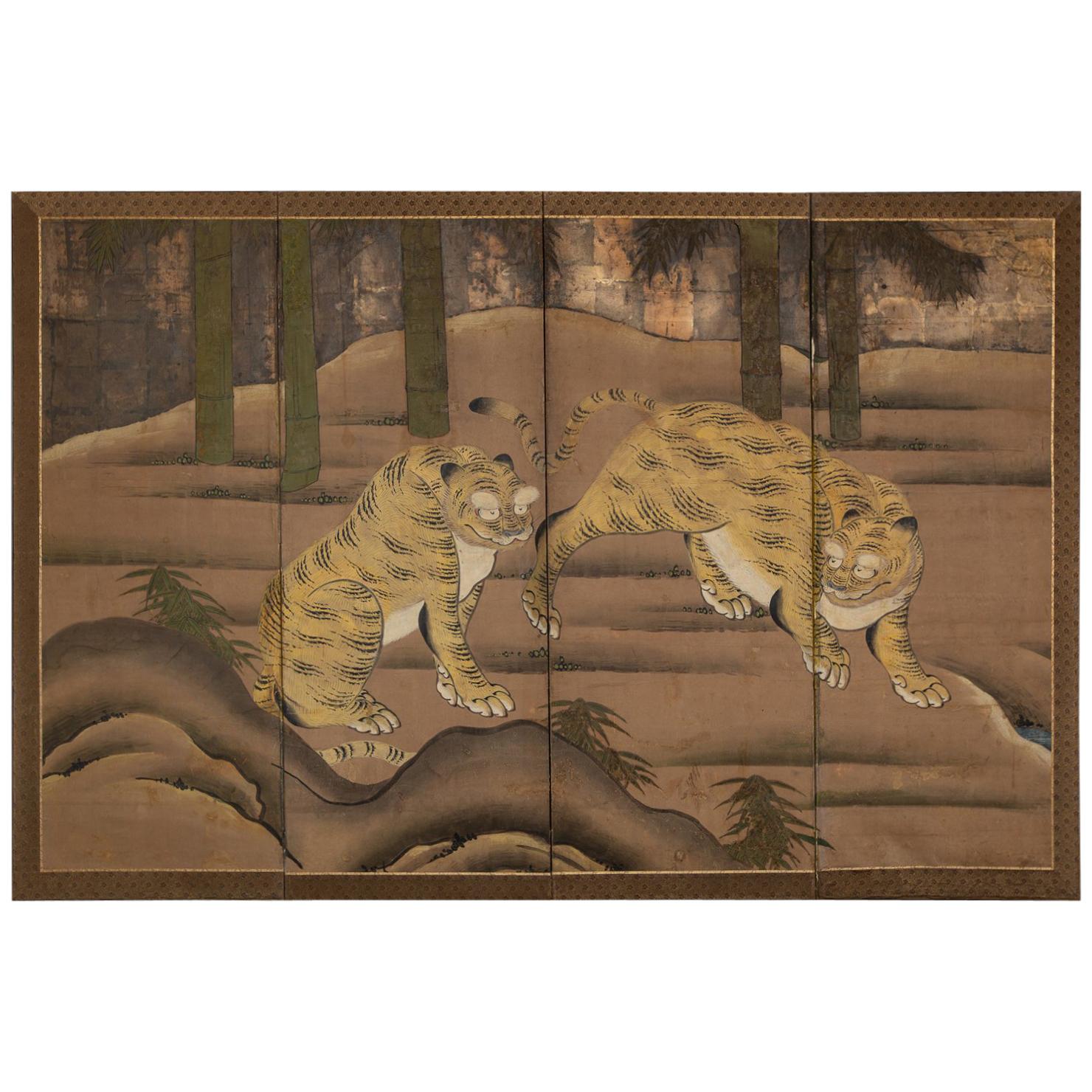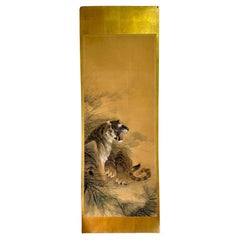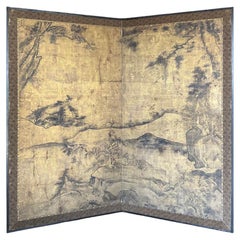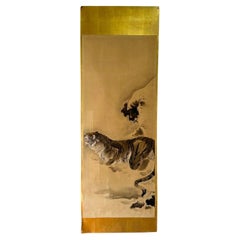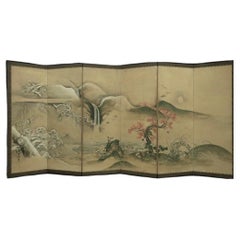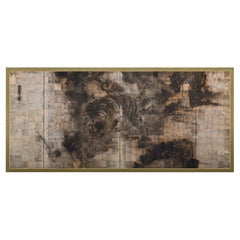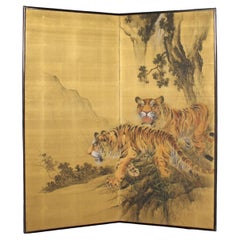Items Similar to 18th Century Nagasaki School Tiger Screen
Want more images or videos?
Request additional images or videos from the seller
1 of 9
18th Century Nagasaki School Tiger Screen
$8,260
£6,267.50
€7,166.32
CA$11,536.98
A$12,827.55
CHF 6,697.84
MX$156,142.55
NOK 85,461.52
SEK 80,073.36
DKK 53,483.59
Shipping
Retrieving quote...The 1stDibs Promise:
Authenticity Guarantee,
Money-Back Guarantee,
24-Hour Cancellation
About the Item
18th Century Nagasaki School Tiger Screen
Period: Edo
Size: 165 x 172 cm (65 x 67.7 inches)
SKU: PTA69
This exceptional 18th-century screen from the Edo period is a remarkable representation of the Nagasaki school of painting, which often featured exotic themes uncommon in traditional Japanese art of the time. With its two-panel breadth, this screen captures the raw power and majestic presence of tigers, animals not native to Japan but whose imagery was popularized through cultural exchange with neighboring China and Korea.
Intricately inked on paper, the tigers are depicted with dynamic energy and fierce grace, a testament to the skilled artists who created vivid and lifelike representations from their imaginations and secondhand accounts. The tigers, symbols of strength and courage, are set against a minimalist backdrop, bringing their commanding presence to the forefront.
This unique piece not only stands as an art collector's treasure but also as a historical narrative that reflects Japan's fascination with foreign wildlife during the Edo period. Its existence celebrates cross-cultural influences and the adventurous spirit of Japanese artistry.
- Dimensions:Height: 60.04 in (152.5 cm)Width: 68.12 in (173 cm)Depth: 0.79 in (2 cm)
- Style:Edo (Of the Period)
- Materials and Techniques:
- Place of Origin:
- Period:
- Date of Manufacture:Unknown
- Condition:Minor losses. Minor fading. Condition report upon request.
- Seller Location:Fukuoka, JP
- Reference Number:1stDibs: LU8121239721132
About the Seller
5.0
Vetted Professional Seller
Every seller passes strict standards for authenticity and reliability
Established in 1998
1stDibs seller since 2023
57 sales on 1stDibs
Typical response time: <1 hour
- ShippingRetrieving quote...Shipping from: Tambon Hang Dong, Thailand
- Return Policy
Authenticity Guarantee
In the unlikely event there’s an issue with an item’s authenticity, contact us within 1 year for a full refund. DetailsMoney-Back Guarantee
If your item is not as described, is damaged in transit, or does not arrive, contact us within 7 days for a full refund. Details24-Hour Cancellation
You have a 24-hour grace period in which to reconsider your purchase, with no questions asked.Vetted Professional Sellers
Our world-class sellers must adhere to strict standards for service and quality, maintaining the integrity of our listings.Price-Match Guarantee
If you find that a seller listed the same item for a lower price elsewhere, we’ll match it.Trusted Global Delivery
Our best-in-class carrier network provides specialized shipping options worldwide, including custom delivery.More From This Seller
View AllLate 19th century (Meiji period) painting depicting tiger
Located in Fukuoka, JP
Antique Tiger Painting on Paper – Meiji Period
A striking depiction of a tiger, painted on paper and signed by the artist. This work was originally part of a Japanese byobu folding ...
Category
Antique Late 19th Century Japanese Meiji Paintings and Screens
Materials
Gold Leaf
Early Edo Period Chinese-Inspired Screen
Located in Fukuoka, JP
This remarkable screen from the early Edo period, circa the 17th century, showcases the influence of early Chinese art forms with its intricate ink work on a gold leafed surface. The...
Category
Antique 17th Century Japanese Edo Paintings and Screens
Materials
Gold Leaf
Late 19th century (Meiji period) painting depicting tiger
Located in Fukuoka, JP
Antique Tiger Painting on Paper – Meiji Period
A striking depiction of a tiger, painted on paper and signed by the artist. This work was originally part of a Japanese byobu folding ...
Category
Antique Late 19th Century Japanese Meiji Paintings and Screens
Materials
Gold Leaf
Edo Period Nature Screen by Kanō Tsunenobu (2/2)
Located in Fukuoka, JP
Embark on a journey through the tranquil beauty of a Japanese screen from the Edo period, crafted by the illustrious Kanō Tsunenobu, a master of the Kanō school and nephew to Kanō Ta...
Category
Antique 18th Century Japanese Edo Paintings and Screens
Materials
Paper
Late Edo period Tsutsugaki 筒描 Auspicious Shishi Batik Screen
Located in Fukuoka, JP
Auspicious Shishi Batik Screen
Period: Late Edo
Size: 145x173 cm (57x68 inches)
SKU: PTA62
Step into the mythical world of late Edo Japan with our radiant batik screen depicting the...
Category
Antique 19th Century Japanese Edo Paintings and Screens
Materials
Cotton, Wood
Edo Period Kyoto Screen (2/2)
Located in Fukuoka, JP
Edo Period Kyoto Screen
Period: Edo period
Size: 343 x 176 cm (134.6 x 69 inches)
SKU: RJ69/2
This stunning Edo period screen depicts typical scenes of...
Category
Antique 18th Century Japanese Edo Paintings and Screens
Materials
Silk, Wood, Paper
You May Also Like
17th Century Japanese Screen Pair. Tiger & Dragon by Kaiho Yusetsu
Located in Kyoto, JP
Kaiho Yusetsu (1598-1677)
Tiger and Dragon
Early Edo Period, Circa 1650
A Pair of Six-fold Japanese Screens. Ink and slight color on paper.
Dimensions:
Each screen: H. 171 cm x W. 380 cm (67.5’’ x 149.5’’)
In this pair of early Edo period Japanese screens a group of tigers prowl in a bamboo grove whipped with fierce wind, while a dragon claws through clouds and mist. The dragon embodies elemental qualities - looming out of the mist, the coils of its body disappearing in the clouds. The dragon is calling for rain, symbolizing spring which is considered the fountain of life. On the other side, the tigers calls for the wind, symbolizing autumn which is considered the end of life. Tigers were familiar motifs within Japanese art from ancient times though the animals were imaginary to the people in the 17th century. While dragons and tigers are usually associated as sacred and ferocious, in this painting, both animals have rather amusing expressions. The tigers appear to glare at the dragon with cat-like eyes, and the look on the swirling dragon’s face appears almost affectionate - lending a playful flair to an otherwise magnificent theme.
The tiger and dragon are cosmological symbols of the balancing forces in the world. Screens such as this were originally meant to express the fluctuating nature of the world. For Japanese in the early Edo period, they likely suggested the powers of the cosmos. In Japan the tiger and dragon motif was originally absorbed into the circles of Zen monasteries before spreading into the secular world. The theme especially appealed to the military classes with the Kano school, the official painters to the Shogun and the samurai, being the leading contributors. The painter of this pair of screens, Kaiho Yusetsu (1598-1677), was closely patronized by the third Shogun Tokugawa Iemitsu. In his later years he worked with Kano school artists...
Category
Antique Mid-17th Century Japanese Edo Paintings and Screens
Materials
Silk, Wood, Paper
Japanese Screen Pair, Tigers by Kishi Renzan, Late Edo Period
Located in Kyoto, JP
Kishi Renzan (1804-1859)
Tigers
Pair of six-panel Japanese screens.
Ink and gold-leaf on paper.
In this monochromatic pair of six-fold Japanese screens painted on gold-leaf, Kishi Renzan has created a breathtaking composition of a family of tigers. The screens are filled with a sense of drama which is conveyed by both the subject matter and the wet, expressive brushwork. The running mountain stream and the towering waterfall allude to refreshment during the summer months and we feel the tiger families familiarity and security within their environment. Renzan’s master, Kishi Ganku...
Category
Antique Mid-19th Century Asian Edo Paintings and Screens
Materials
Gold Leaf
Edo period Japanese Screen. Tiger and Pine by Kishi Ganku.
Located in Kyoto, JP
Kishi Ganku (1749/1756-1838)
Tiger and Pine
A six-panel Japanese Screen. Ink on silver leaf.
The central focus of this Japanese screen is a large tiger, emerging from shadow, crou...
Category
Antique Late 18th Century Japanese Edo Paintings and Screens
Materials
Silver Leaf
B13 Japanese Antiques 2panels, silk, folding Screen with Tiger
Located in Niiza, JP
Material: Silk on wooden frame
One piece: W685×H1525mm×D20mm,
Unfolded size: W1370mm
Folded size: W685×H1525×D40mm, 5kg
Packaging (sandwiched with 5mm plywood): 10cm x 77cm x 160cm, ...
Category
20th Century Japanese Paintings and Screens
Materials
Silk
Japanese Four Panel Screen: Two Tigers
Located in Hudson, NY
Two tigers exchanging amorous glances. Kano School painting.
Category
Antique 18th Century Japanese Paintings and Screens
Materials
Paper
19th Century Japanese Paintings. Zenga Tiger and Dragon by Inoue Kanshu.
Located in Kyoto, JP
Inoue Kanshu (1807-1880)
Zenga Tiger and Dragon
19th century
Pair of framed Japanese paintings. Ink on silk.
Dimensions (each): W. 114 cm x H. 115 cm (45” x 45”)
Presented here ...
Category
Antique Mid-19th Century Japanese Meiji Paintings and Screens
Materials
Silk
More Ways To Browse
Wood Screen
The Tiger
Tiger Furniture
Antique Tiger
Tiger Woods
Asian Tiger
Asian Tiger Art
Hand Painted Tiger
Tiger China
Antique Tiger Wood
Japanese Tiger
18th Century Hand Screen
Antique Tiger Wood Furniture
Painted Paper Panels Chinese
18th Century Japanese Screens
Korean Panel
18th Century Chinese Screen
Tiger Screen
